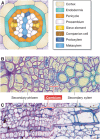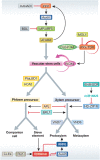Stem cell function during plant vascular development
- PMID: 23169537
- PMCID: PMC3553377
- DOI: 10.1038/emboj.2012.301
Stem cell function during plant vascular development
Abstract
The plant vascular system, composed of xylem and phloem, evolved to connect plant organs and transport various molecules between them. During the post-embryonic growth, these conductive tissues constitutively form from cells that are derived from a lateral meristem, commonly called procambium and cambium. Procambium/cambium contains pluripotent stem cells and provides a microenvironment that maintains the stem cell population. Because vascular plants continue to form new tissues and organs throughout their life cycle, the formation and maintenance of stem cells are crucial for plant growth and development. In this decade, there has been considerable progress in understanding the molecular control of the organization and maintenance of stem cells in vascular plants. Noticeable advance has been made in elucidating the role of transcription factors and major plant hormones in stem cell maintenance and vascular tissue differentiation. These studies suggest the shared regulatory mechanisms among various types of plant stem cell pools. In this review, we focus on two aspects of stem cell function in the vascular cambium, cell proliferation and cell differentiation.
Conflict of interest statement
The authors declare that they have no conflict of interest.
Figures








Similar articles
-
Molecular control of cell specification and cell differentiation during procambial development.Annu Rev Plant Biol. 2014;65:607-38. doi: 10.1146/annurev-arplant-050213-040306. Epub 2014 Feb 21. Annu Rev Plant Biol. 2014. PMID: 24579995 Review.
-
Bifacial cambium stem cells generate xylem and phloem during radial plant growth.Development. 2019 Jan 9;146(1):dev171355. doi: 10.1242/dev.171355. Development. 2019. PMID: 30626594 Free PMC article.
-
Cell-to-cell movement of two interacting AT-hook factors in Arabidopsis root vascular tissue patterning.Plant Cell. 2013 Jan;25(1):187-201. doi: 10.1105/tpc.112.102210. Epub 2013 Jan 18. Plant Cell. 2013. PMID: 23335615 Free PMC article.
-
Regulation of vascular cell division.J Exp Bot. 2017 Jan;68(1):27-43. doi: 10.1093/jxb/erw448. Epub 2016 Dec 12. J Exp Bot. 2017. PMID: 27965363 Review.
-
CLE peptides in vascular development.J Integr Plant Biol. 2013 Apr;55(4):389-94. doi: 10.1111/jipb.12044. J Integr Plant Biol. 2013. PMID: 23473393 Review.
Cited by
-
Role of hormones in controlling vascular differentiation and the mechanism of lateral root initiation.Planta. 2013 Nov;238(5):819-30. doi: 10.1007/s00425-013-1927-8. Epub 2013 Jul 9. Planta. 2013. PMID: 23835810 Review.
-
The BOP-type co-transcriptional regulator NODULE ROOT1 promotes stem secondary growth of the tropical Cannabaceae tree Parasponia andersonii.Plant J. 2021 Jun;106(5):1366-1386. doi: 10.1111/tpj.15242. Epub 2021 Apr 7. Plant J. 2021. PMID: 33735477 Free PMC article.
-
iTRAQ-based comparative proteomic analysis of differences in the protein profiles of stems and leaves from two alfalfa genotypes.BMC Plant Biol. 2020 Sep 29;20(1):447. doi: 10.1186/s12870-020-02671-2. BMC Plant Biol. 2020. PMID: 32993512 Free PMC article.
-
Convergence between Development and Stress: Ectopic Xylem Formation in Arabidopsis Hypocotyl in Response to 24-Epibrassinolide and Cadmium.Plants (Basel). 2022 Nov 28;11(23):3278. doi: 10.3390/plants11233278. Plants (Basel). 2022. PMID: 36501318 Free PMC article.
-
Transcriptional Roadmap to Seasonal Variation in Wood Formation of Norway Spruce.Plant Physiol. 2018 Apr;176(4):2851-2870. doi: 10.1104/pp.17.01590. Epub 2018 Feb 27. Plant Physiol. 2018. PMID: 29487121 Free PMC article.
References
Publication types
MeSH terms
LinkOut - more resources
Full Text Sources
Other Literature Sources
Medical

